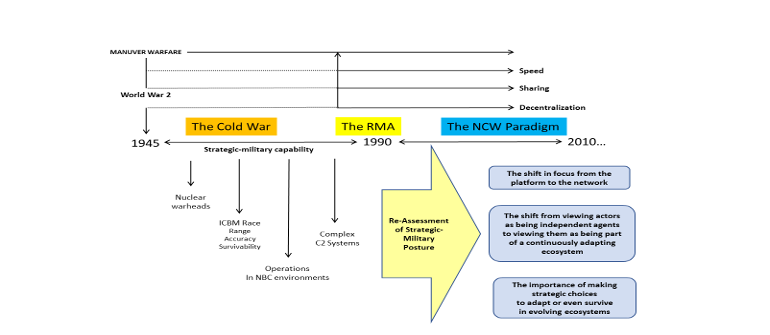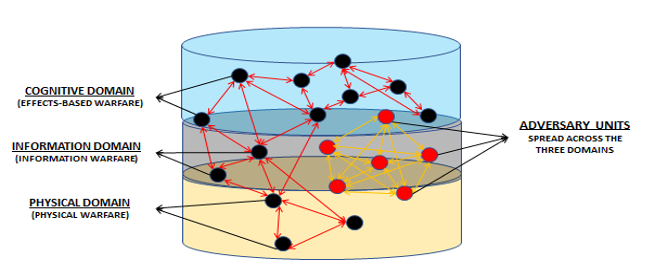If we take a step back and cast a reflective eye over the evolutionary trajectory of western military thought, we will find that in around the 1990s—as Information and Communication Technologies (ICTs) began to proliferate—discussions regarding the latest Revolution in Military Affairs also started to gather pace.

It was in this context that some military theorists began to think in terms of a “new” theory of warfare. Recognizing that the “time we live in [is] unlike any other…a time when the pace of change demands that we change…” (Alberts et al, 2001: xiii), it was argued that it was fast becoming an imperative to craft “an emerging military response to the Information Age” (Alberts et al, 2000: 88). This would require, the theorists asserted, “a new way of thinking – network-centric thinking…” (Alberts et al, 2000: 88) and a “shift in focus from the platform to the network…” (Gartska & Cebrowski, 1998). Thus, was born the theory of network-centric warfare (NCW).

By 2003, the US was heavily involved in the Iraq War and, under such conditions, the theory of NCW fell prey to the demands of urgent operationalization resulting in a critical failure to think through the nuances and implications of “network-centric thinking”. Further, dismal battlespace outcomes in the Afghan and Iraqi theatres led many to dismiss the theory as a failure.
Given our progressive immersion in an “internet of things”, which is exhibiting growing levels of ambient intelligence, and with the human condition being increasingly subjected to subtle forms of what Gernot Böhme refers to as “invasive technification”, the imperative to think about martial operability in network-centric terms has both a conceptual allure and a growing operational imperative. But to do this, we will need to “change…how we think” (Rumsfeld, 2002: 29).
In my recent article in Security Dialogue, against the backdrop of an emerging “internet of things” marked by a growing “ambient intelligence”, I explore how Gilbert Simondon’s philosophy of technology which, by seeking an “understanding [of] technological elements, machines and ensembles…from the perspective of their genesis” (Fisch, 2018: 30), and by, among other things, invoking the notion of intensive and extensive reticularity, expands on what he refers to as “technical reality” in which “the role or function of the human [is] between machines” (LeMarre, 2013: 82) may be useful to construct a conceptual armature around which the project of rethinking and revising the theory of NCW may be undertaken in a manner that is responsive to the Age of Information and, prospectively, of Artificial Intelligence, albeit in a manner free from the intemperate technicism that has thus far held the theory of NCW captive.
References
Alberts DS, Gartska J, Stein F (2000) Network Centric Warfare: Developing and Leveraging Information Superiority 2nd Revised Edition (CCRP Program). Washington, DC: US Dept. of Defense
Alberts DS, Gartska JJ, Hayes RE, Signouri DA (2001) Understanding Information Warfare (CCRP Program). Washington DC: Dept. of Defense
Bohme G (2012) Invasive Technification: Critical Essays in the Philosophy of Technology, Trans. Shingleton C. London: Bloomsbury Academic
Fisch M (2018) An Anthropology of the Machine: Tokyo’s Commuter Train Network. Chicago: University of Chicago Press
Garstka JJ and Cebrowski AK (1998) Network Centric Warfare: Its Origin and Future. In Proceedings Volume 124/1/1, 139
LeMarre T (2013) Afterword. In Combes M Gilbert Simondon and the Philosophy of Transindividuation, Trans. LeMarre T, Cambridge: MA: MIT Press
Rumsfeld D (2002) Transforming the Military. In, Foreign Affairs, vol. 81, no. 3, May/June, Available at https://www.foreignaffairs.com/articles/2002-05-01/transforming-military (accessed Oct 24, 2020)